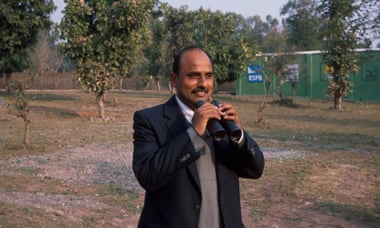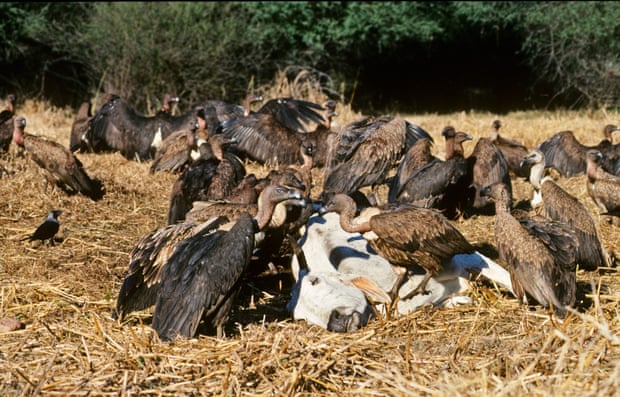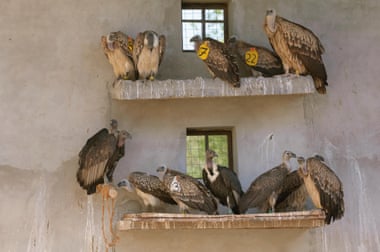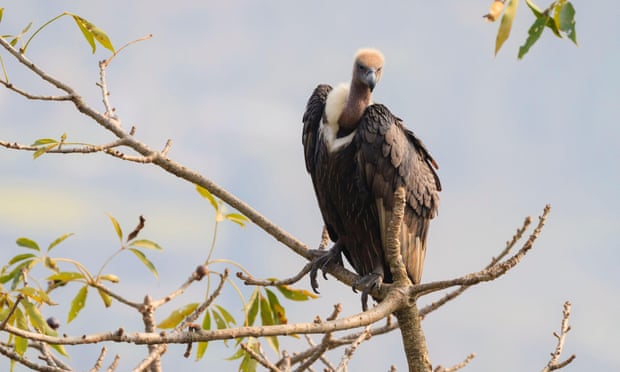August 28, 2021
In February, the doors of an aviary in West Bengal’s Buxa tiger reserve were flung open. Eight critically endangered captive-bred white-rumped vultures cautiously emerged and within minutes were mingling with wild vultures, devouring the meat of carcasses left out by a team of researchers from the Bombay Natural History Society (BNHS).
The birds were raised in a nearby breeding centre by BNHS, led by assistant director Sachin Ranade, as part of efforts to save India’s Gyps vultures. Gradually, some of the released vultures perched on trees with their wild cousins, while others returned to the wire-mesh aviary where they had spent the previous few months getting acclimatised to their surroundings.
There is hope but it depends on how responsible society becomes
Dr Vibhu Prakash, BNHS deputy director
Similar releases took place in January of two white-rumped vultures in West Bengal and in October last year in Haryana, northern India, when eight birds were set free from the world’s largest vulture breeding facility.
These captive-bred birds are the first to be released into the wild since conservation efforts began about two decades ago, focusing on three critically endangered species: the slender-billed, the white-rumped and the long-billed or Indian vulture. Since then, a successful breeding programme has seen new fledglings each year with hundreds successfully reared in four centres.
Researchers from BNHS, an organisation dedicated to wildlife research and nature conservation, estimate India was home to 40 million vultures in the 1980s. That number dropped by more than 97% in the 1990s, largely because of the use of a non-steroidal anti-inflammatory drug (NSAID) called diclofenac, routinely used to treat cattle. India has a large bovine population – about 302 million according to a 2019 estimate – whose carcasses vultures feed on.

Dr Vibhu Prakash, the deputy director of BNHS, witnessed the drop in numbers while conducting research in Rajasthan’s Keoladeo national park in the mid-1990s. “We saw dead and sick vultures, with drooping necks. Once these symptoms appeared they usually died within 10 to 15 days,” he says. Postmortems revealed chalky white deposits on the birds’ organs, a sign of visceral gout.
In 2001, Prakash and his team set up a vulture care centre in Pinjore, Haryana, to study the cause of mortality and treat sick birds. Around this time, US researchers in Pakistan, who were studying vultures, found similar chalky deposits and traces of diclofenac in their tissues. They fed the birds buffalo meat injected with the drug and noticed that they developed the same symptoms and died shortly after. “It was clear evidence that diclofenac kills vultures,” Prakash says.
When researchers examined bird tissues in Pinjore they found that 76% of the birds had died of diclofenac. In 2004, the BNHS team consulted Cambridge professor Rhys Green to understand what quantities of diclofenac-laced carcasses would cause such sharp population drops in the vultures.
“Prof Green estimated that if less than 0.8% of cattle carcasses had diclofenac it can cause this kind of crash,” Prakash says. “We sampled carcasses over 2,000 locations and found more than 11% had diclofenac.”

That same year, the BNHS team, together with national and international experts and public and private stakeholders, created an action plan to save vultures. This included a conservation breeding programme, identifying safe NSAIDs, and stopping the use of diclofenac.
The care centre in Pinjore was converted into a breeding facility, with large aviaries built to provide nesting spaces. Gradually, three more breeding centres were set up in West Bengal, Assam and Madhya Pradesh. Prakash’s team worked with the national Central Zoo Authority to open four smaller facilities in other parts of the country.

Breeding vultures is a slow process – they mature when they are about five years old and lay only one egg a year. The team uses natural and artificial incubation methods to raise chicks of the three critically endangered species in captivity. Today, there are more than 700 vultures across the breeding centres.
In 2006, the Indian government banned the veterinary use of diclofenac after a long campaign and search for a substitute drug. But diclofenac continued to cause vulture deaths because it was legally available for human use in big vials, and in some cases was being sold illegally for veterinary use. People were buying it from pharmacies and administering large doses to cattle. Prakash and his colleagues pushed the government to reduce the vial size to 3ml, the normal human dose, and an official order was passed in 2015.
Simultaneously, researchers like Ranade, who oversees the West Bengal and Assam centres, were working to create vulture safe zones. Ranade says there are ongoing efforts to achieve this, including meetings with officials, village leaders and cattle owners, monitoring the availability of diclofenac and conducting surveys of vulture populations.
Diclofenac use has come down substantially because of the efforts of conservation groups and support from organisations such as Saving Asia’s Vultures from Extinction (Save), a consortium of international partners. But, Prakash says, there is still more to be done. Last year, BNHS partnered with Indian officials to launch a five-year action plan, which calls for more breeding centres and safety testing of drugs.

As for more releases, the team will track the progress of the satellite-tagged vultures freed in the past year before considering the next step. “If none of the vultures have drug-related mortality then we will release about 20 to 30 birds every year,” Prakash says.
Prakash is confident vultures will not go extinct, but says their survival depends on humans.
“We have to ensure that we follow best veterinary practices, that their food is not contaminated and carcasses are disposed of properly,” he says. “There is hope, but it depends on how responsible society becomes.”
This article by Kamakshi Ayyar was first published by The Guardian on 19 August 2021. Lead Image: A long-billed vulture on the ramparts of Mehrangarh Fort, Jodhpur, one of three critically endangered vulture species being bred in captivity by Indian conservationists. Photograph: Bernard Castelein/naturepl.com.
What you can do
Support ‘Fighting for Wildlife’ by donating as little as $1 – It only takes a minute. Thank you.
Fighting for Wildlife supports approved wildlife conservation organizations, which spend at least 80 percent of the money they raise on actual fieldwork, rather than administration and fundraising. When making a donation you can designate for which type of initiative it should be used – wildlife, oceans, forests or climate.
(Sources: Focusing on Wildlife)












Đăng nhận xét